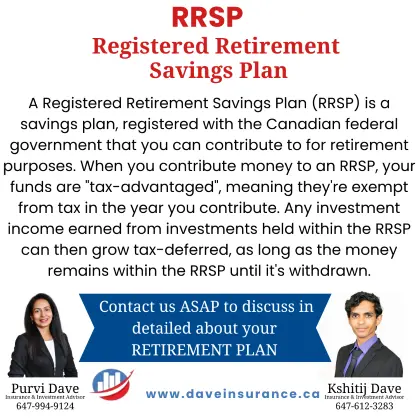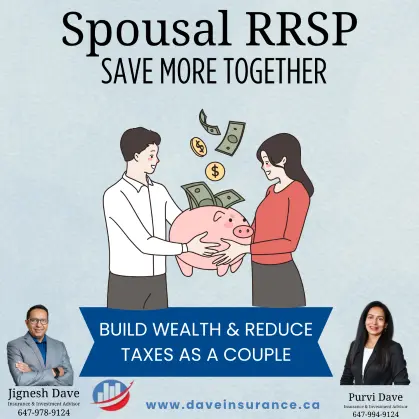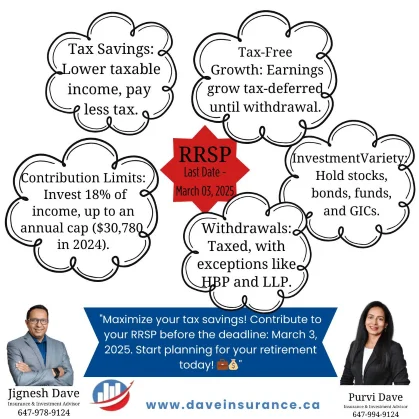RRSP Services in Ontario – Plan Smart. Retire Strong with Dave Financial Services Inc.
We help clients across Ontario build a secure financial future through strategic use of Registered Retirement Savings Plans (RRSPs). Whether you’re new to investing or approaching retirement, our customized RRSP planning services ensure you maximize tax benefits, long-term growth, and financial flexibility.

What Is an RRSP?
An RRSP (Registered Retirement Savings Plan) is a government-registered account designed to help Canadians save for retirement while reducing taxes. Contributions to an RRSP are tax-deductible, and your investments grow tax-deferred until you withdraw funds—usually in retirement when your income (and tax rate) may be lower.

What Are the Tax Advantages of an RRSP?
RRSPs offer multiple tax benefits to Ontario residents:
- Reduce taxable income: Contributions are deducted from your annual income, lowering your tax bill.
- Tax-sheltered growth: Investments inside the RRSP grow without being taxed until withdrawal.
- Tax-efficient withdrawals: Post-retirement withdrawals are taxed at your marginal rate—often lower than during your working years.
This combination of tax deferral and compounding growth makes the RRSP a powerful long-term savings vehicle.
RRSP Contribution Rules: How Much Can You Contribute?
Your annual RRSP contribution limit is based on:
- Your unused contribution room carried forward from previous years.
- The lower of:
- 18% of your earned income from the previous tax year.
- $31,560 for 2024 or $32,490 for 2025.
- Minus any pension adjustment, if applicable.
Over-Contribution Warning: You can exceed your limit by up to $2,000 without penalty. Beyond that, you’ll pay a 1% tax per month on the excess amount. Avoid costly mistakes by consulting our Ontario RRSP specialists at Dave Financial Services Inc.
Types of RRSP
Individual RRSP:
It can be set up by a single person who is both the account holder and the contributor.
Spousal RRSP:
The high-income earner spouse contributes to the other spouse's RRSP. The contributor gets the tax deduction, but the money is now owned by the other spouse. So, when the money is withdrawn from the spousal RRSP, it's taxed at the lower-income spouse's rate. This is a form of income-splitting that is especially useful when one spouse has a significantly higher retirement income than the other.

Group RRSP:
These are set up at work by an employer for employees. The employee and/or the employer contribute money to individual RRSP accounts. Contributions are deducted from paycheques, so the tax savings are immediate. Investment choices may be limited.
A Pooled RRSP:
PRPP (Pooled Registered Pension Plan) is a new kind of deferred income plan designed to provide retirement income for employees and self-employed individuals who do not have access to a workplace pension.
Self-directed RRSP:
Do-it-yourself investors set up self-directed plans that can hold a wide range of investments together in one plan.
What Can You Hold in an RRSP?
An RRSP isn't just a savings account. You can hold a variety of qualified investments inside your RRSP, including:
- Mutual funds.
- Exchange-Traded Funds (ETFs).
- Guaranteed Investment Certificates (GICs).
- Stocks and Bonds.
- Segregated Funds and more.
Our advisors help you build a diversified RRSP portfolio tailored to your risk tolerance and retirement goals.

Can You Withdraw from Your RRSP Before Retirement?
Yes, but early withdrawals from your RRSP are considered taxable income and may be subject to withholding tax unless withdrawn under a special program. Consider these exceptions:
Times You May Want to Withdraw:
Withdraw up to $35,000 tax-free to buy your first home, repayable over 15 years.
Withdraw up to $10,000 per year (max $20,000) to fund you or your spouse’s education, repayable over 10 years.
In other cases, early withdrawals could impact your retirement savings and should be evaluated carefully. Dave Financial Services Inc. can help you explore smarter withdrawal strategies.
Group RRSP vs. Individual RRSP – What’s the Difference?
An Individual RRSP is set up and managed by you (with guidance from professionals like us).
A Group RRSP, often offered by employers, is administered through payroll deductions.
| Feature | Individual RRSP | Group RRSP |
|---|---|---|
| Who controls it | You | Employer-sponsored |
| Contributions | Flexible | Deducted from your pay |
| Investment choices | Broad range | May be limited |
| Tax deduction | Yes | Yes |
| Portability | Fully portable | May need to transfer when you leave your job |
Need help deciding? We’ll walk you through which RRSP plan fits your lifestyle and career path best.
Do You Need a TFSA, FHSA or an RRSP?
| Feature | Tax-Free Savings Account (TFSA) | Registered Retirement Savings Plan (RRSP) | First Home Savings Account (FHSA) |
|---|---|---|---|
| Purpose | General-purpose savings | Retirement savings | Saving for your first home purchase |
| Who Can Open | Must be a Canadian resident with a SIN | Canadian resident under 71 with income | Canadian resident, age 18+, first-time homebuyer |
| Tax Deductible Contributions? | ✓ Yes – reduces taxable income | ✓ Yes – reduces taxable income | |
| Tax on Withdrawals | ✗ No – withdrawals are tax-free | ⚠ Yes – withdrawals are taxed unless for HBP or LLP | ✓ Tax-free if used for buying your first home |
| Withdrawal Restrictions | Withdraw any time, no penalties | Withdrawals may be taxed or penalized unless for qualifying programs | Must be used for a qualifying home purchase within 15 years |
| Contribution Limits | Annual limits set by CRA (e.g., $6,500 in 2023) | Annual limits set by CRA (e.g., $30,780 in 2023) | Up to $8,000/year, lifetime max $40,000 |
| Can You Invest with It? | ✓ Yes – wide investment options available | ✓ Yes – includes stocks, bonds, mutual funds, etc. | ✓ Yes – similar investment flexibility |
| Tax on Investment Growth | ✗ No – growth is not taxed | ✓ Tax-deferred – taxed upon withdrawal | ✓ Tax-free if used for first home |
| Account Expiry? | ✗ No expiry – keep indefinitely | ✗ No expiry – but must convert to RRIF/LIF by age 71 | ✓ Yes – must be closed within 15 years of opening |
| How Withdrawals Work | Tax-free and can recontribute next year | Taxable unless withdrawn under HBP or LLP rules | Tax-free if used to buy a home within the set conditions |
| What Happens at Retirement? | No effect – continue using | Must convert to RRIF or annuity by age 71 | Funds must be withdrawn or transferred to RRSP after 15 years or by age 71 |
Not sure which to prioritize? Dave Financial Services Inc. provides custom financial planning across Ontario to help you find the right balance between RRSP and TFSA contributions.
Why Choose Dave Financial Services Inc. for RRSP Planning in Ontario?
At Dave Financial Services Inc., our mission is to help you grow, protect, and access your retirement savings with confidence. Based in Ontario, we offer:
- Personalized RRSP planning.
- Smart tax-saving strategies.
- Investment portfolio management.
- Support for HBP, LLP, and RRIF conversion.
- Ongoing support through every stage of life.
